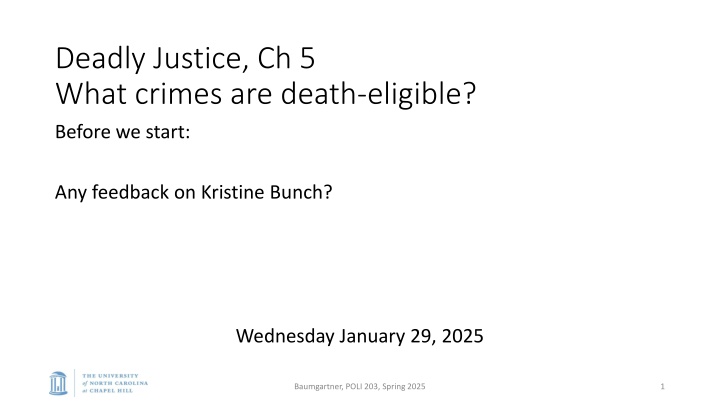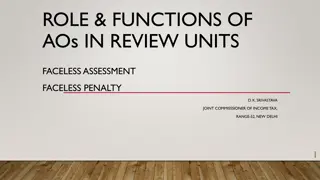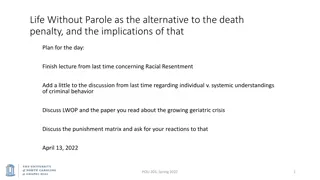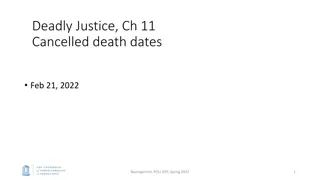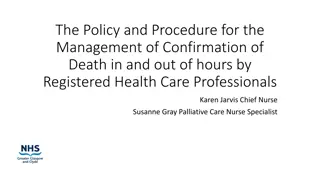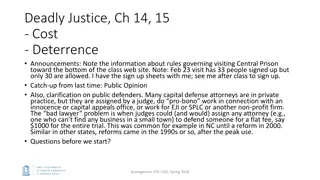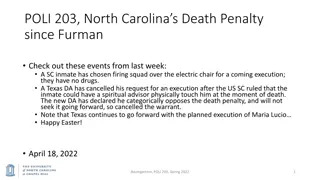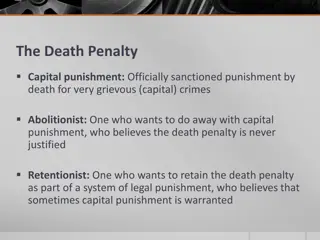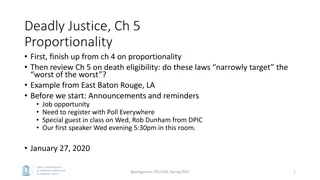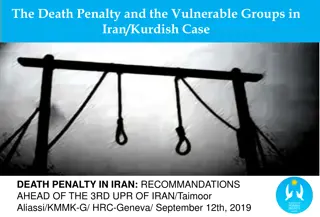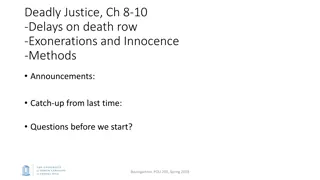Death Penalty Eligibility Factors
Criteria for death eligibility in the criminal justice system, including aggravating factors, mitigators, and the role of legislatures in determining death-eligible crimes. Learn about the Model Legal Code from the American Bar Association and considerations for capital punishment cases.
Uploaded on Apr 16, 2025 | 0 Views
Download Presentation

Please find below an Image/Link to download the presentation.
The content on the website is provided AS IS for your information and personal use only. It may not be sold, licensed, or shared on other websites without obtaining consent from the author.If you encounter any issues during the download, it is possible that the publisher has removed the file from their server.
You are allowed to download the files provided on this website for personal or commercial use, subject to the condition that they are used lawfully. All files are the property of their respective owners.
The content on the website is provided AS IS for your information and personal use only. It may not be sold, licensed, or shared on other websites without obtaining consent from the author.
E N D
Presentation Transcript
Deadly Justice, Ch 5 What crimes are death-eligible? Before we start: Any feedback on Kristine Bunch? Wednesday January 29, 2025 Baumgartner, POLI 203, Spring 2025 1
From Chapter 4: Narrow Targeting, Substantial Proportion, Proportionality Review From Furman: Narrowly target the class of eligible offenders to those who commit particular crimes But what if the DA lobbies the legislature and says: give me the discretion to seek death in cases that are just beyond the pale: especially heinous atrocious, and cruel (EHAC). You can trust me to use this discretion wisely. So, we need to assess: did the legislatures write narrowly targeted laws, or did they put in some wiggle room for DA s to cover other deserving cases ? Substantial proportion: among those who did such crimes, a substantial proportion (whatever that means) should get death Proportionality review: On direct appeal, state supreme court must review whether the case deserves it, compared to other cases How I would do this, as a social scientist; how the courts do this, in fact. Baumgartner, POLI 203, Spring 2025 2
Death Eligibility, Aggravators, and Mitigators Each state has to enumerate the crimes making the offender eligible for death. Often, those are the same as the legal aggravators: killing a small child, killing a police officer, killing after having been previously convicted of murder (e.g., you are a serial killer), etc. So, committing an aggravated murder makes you eligible. Mitigators: cannot be enumerated, juries can consider anything. Death eligibility: without these aggravators laid out in law, you cannot be tried capitally. You can t face the death sentence. Penalty phase: weigh the aggravators and the mitigators, for those found eligible and then convicted of a capital crime. Baumgartner, POLI 203, Spring 2025 3
Note a confusing vocabulary issue Death-eligible crimes (Eligibility Factors) States must enumerate the characteristics or circumstances that make a crime eligible for the death penalty. Example: Killing a child These are supposed to enumerate the most heinous crimes, which justifies the use of the death penalty. Aggravating Factors Elements of the crime that generate death-eligibility Also used in the penalty phase to assess the trade-off compared to mitigating factors. No eligibility factors, no capital prosecution. But the death penalty is never mandatory; it s not automatic. Baumgartner, POLI 203, Spring 2025 4
Model Legal Code from the Amer. Bar Assn. (Table 5.2) Offender is already in prison Repeat offender Multiple victims great risk of death to many persons Felony murder Avoid arrest or escape from prison pecuniary gain (murder for hire / mob hits / contract killing) especially heinous, atrocious, or cruel, manifesting exceptional depravity Baumgartner, POLI 203, Spring 2025 5
The big aggravators that expand the reach of the death penalty Felony murder Robbery Any break-in, assault, or other common crime is now death-eligible. Very few homicides, in fact, are NOT eligible, given that they are often committed during another crime, for example a robbery. Also, if you punch the victim before killing them, that s assault, a separate felony. Or if you restrain their movement, that s kidnapping. Note that by the law of parties even the non-trigger person, or accomplice in the felony is eligible for the full punishment. (Practically speaking, it means the trigger-person often turns against the others, knowing they face death, and the others think they can t possibly get it.) 22 people have been executed but did not kill the victim: https://deathpenaltyinfo.org/executions/executions-overview/executed-but-did-not- directly-kill-victim Baumgartner, POLI 203, Spring 2025 6
Big aggravators, cont. Especially heinous, atrocious, and cruel (EHAC) Exceptional depravity (name me a murder that does not qualify!) These make sense but it s hard to draw the line, and they provide very open discretion to a DA. ABA recommended it; DA s like the discretion on average, just so a case doesn t slip through, where there is heavy popular pressure, so many legislatures included this. Baumgartner, POLI 203, Spring 2025 7
Big aggravators, cont. Lying in wait (California) Future dangerousness (Texas) Pecuniary gain Contract killers, not that common. But if you take a bracelet from the victim, you made a financial gain, and the DA may use this to charge you capitally. Law presumably designed to target contract killers, but once on the books can be interpreted more broadly, and it has been. Risk to many (any killing on a public street, or with others present. No definition of many ) Baumgartner, POLI 203, Spring 2025 8
Narrow targeting + substantial proportion = fair In Furman and Gregg, this is essentially what the justices called for. List the really bad crimes. Prosecute those crimes with capital punishment if they occur. Allow juris to exercise mercy when the circumstances warrant it. Furman: a small handful of eligible offenders was randomly selected, like being struck by lightning. So in Gregg the idea was to remedy that problem with this equation. Baumgartner, POLI 203, Spring 2025 9
Mercy, discretion, and substantial proportion What is a substantial proportion and how would we know if enough offenders are getting the death penalty? If it s just for cop killers or people serving a life term in prison already, then maybe you d expect a very large proportion of them to get death, maybe. That seems to be the idea in Gregg. So we want to look BOTH at whether the statute is narrow, and ALSO whether a substantial proportion of such offenders are condemned. If not, this may leave room for bias. Baumgartner, POLI 203, Spring 2025 10
Lets look at how this plays out in one place Capital and Non-Capital Murder Prosecutions in East Baton Rouge Parish, Louisiana, 2000 2016 I did this report based on data collected by the appellate defender s office in Baton Rouge, in March 2019 Part of an appeal from an inmate who was sentenced to death. His argument: he s not particularly more heinous or deserving than many others who committed homicide but did not get the same punishment. So we reviewed every homicide in that parish, over 17 years. Baumgartner, POLI 203, Spring 2025 11
550 homicides from East Baton Rouge, LA Baumgartner, POLI 203, Spring 2025 12
Offender characteristics, 86% black, 92% male, very young on average Baumgartner, POLI 203, Spring 2025 13
Victim characteristics: 74% black, 82% male, 91% just one victim, 550 offenders, 607 victims. Victims also pretty young, but not always. Baumgartner, POLI 203, Spring 2025 14
Offender victim racial combinations Black offenders: 10% white victims, 82% black victims White offenders: 58% white victims, 19% black victims Black offender, white victim: 47 cases of 550, 8% Black male offender, white female victim: 13 cases, 2% Baumgartner, POLI 203, Spring 2025 15
Aggravators Baumgartner, POLI 203, Spring 2025 16
Charges. Note that 2/3 had at least one aggravating factor Charge First degree, capital First degree, non-capital Second degree Lesser charges only Number Percent 35 53 460 6 10 84 0 2 Total 550 100 Baumgartner, POLI 203, Spring 2025 17
Punishments Punishment Offenders Percent Not guilty or no prison 67 12 Term sentence 267 49 Life in prison 146 27 Death 6 1 Unknown or not settled yet 64 12 Total 550 100 Baumgartner, POLI 203, Spring 2025 18
For the 267 who got a term sentence, how long was it? Baumgartner, POLI 203, Spring 2025 19
Legally relevant factors matter. But look how many still got second- degree Baumgartner, POLI 203, Spring 2025 20
Legally irrelevant factors also matter Baumgartner, POLI 203, Spring 2025 21
How irrelevant factors increase the odds of seeking death. Baumgartner, POLI 203, Spring 2025 22
A logistic regression model predicting capital prosecution. Predictor variable Odds- Ratio 2.24 Prob. Number of victims .138 Number of aggravators 3.36 .033 Black offender black victim 0.41 .107 White offender white victim White offender black victim 0.64 0.82 .617 .885 Black male offender white female victim 14.49 .003 Drug-related Victim less than 12 0.19 6.13 .076 .109 Victim greater than 64 13.8 .007 Other insignificant predictors included in the model: Arson, Burglary, Risk to Many, Drive-by, Prior killing, Kidnapping, Contract killing, cruelty to juveniles N = 458, pseudo-R2 = .3592 Baumgartner, POLI 203, Spring 2025 23
These findings similar to those of Baldus for Georgia Legally relevant factors do indeed increase the odds of facing capital punishment But they do not guarantee it. In fact, they are pretty weak, and many people see only 2nd degree charges Legally irrelevant factors matter, consistent with every study ever done. Response by the courts so far: We don t trust social science. Maybe there are other factors, such as attitude or lack of remorse, that are not controlled. DA s, judges, and juries can assess things that can t be quantified Baumgartner, POLI 203, Spring 2025 24
Where we stand There is a lot of evidence about bias. But courts are loathe to accept it. Some states have abolished based on these factors. Federal government now strongly going to support expanded use of the death penalty. US Supreme Court can be expected to back it. The flaws social scientists can identify and document are dismissed as gobbledygook or irrelevant based on the fact that a jury sees more information. But juries never compare across cases to assess proportionality. So, a paradox. Baumgartner, POLI 203, Spring 2025 25
